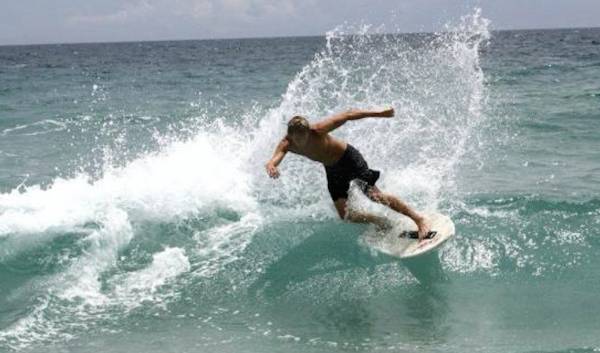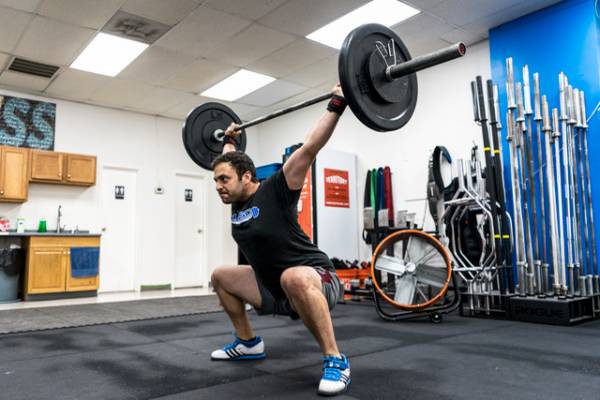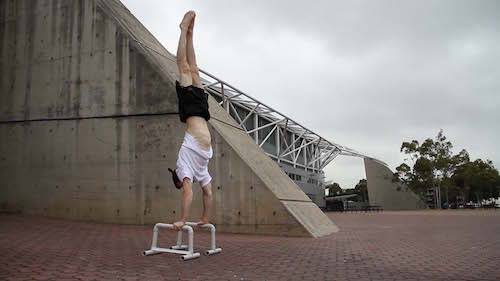I want to share with you a method of how to teach yourself just about anything. This method of acquiring skills is a combination of concepts I was taught and others that I’ve found through trial and error by teaching myself and coaching others for over a decade. I’ve used this approach to teach myself back flips, presses to handstand, ring movements, multiple gymnastics elements, Olympic lifting, juggling, slacklining, and skimboarding.
I won’t call myself an expert at any of these movements, and the scars on my feet and legs from the skimboarding confirm this, but I love the process of learning new skills. While everyone learns differently, and each skill has its own unique set of challenges, this model has helped me as an athlete and as a coach.
The Model of Skill Acquisition
Let me start with giving credit to Dr. Mike Jacobs from Shepherd University. Dr. Jacobs developed something called the Shepherd College Teaching Model and taught it to myself and many others in a course called “Perceptions of Motor Learning.” He was passionate about this teaching strategy and used it to teach himself everything from sailing to recovering his abilities after suffering a stroke. While I started teaching myself various skills as a child, this model got me thinking more about the process of learning a new skill and gave me inspiration to create a model of my own. So, without further ado, here’s my Model of Skill Acquisition.
1. Familiarize Yourself with the Skill
Do you know what the entire movement looks like? As simple as this sounds, you have to have seen the movement and have a basic understanding of it before you can work towards doing it. Visualization is key. Imagine yourself performing it from a third person point of view. This is why I always demo movements for my class since before I give instruction. They need to see what we’re working towards. If you want to learn a skill, make sure you watch someone perform it correctly, then visualize yourself with the same form to gain an understanding of what you need to do.
2. Use Imitation
Imitation is how I taught myself how to play the drums. After just a year of lessons, I’d sit beside the radio and play along with what I was hearing. I joined bands with absentee drummers and I played the parts they wrote. Before long, I was able to make up my own parts because I had the basic framework down. That was 19 years ago, but when I want to learn a new song for church I’ll watch a video of a drummer doing it before we practice, then repeat it and add my own style to it. This learning model is kind of specific to movement, but elements of it can be applied elsewhere.

3. The Method of Progression
Can you break the skill down into steps, understand each step, and start at the very beginning? These steps are called progressions. You need to figure out the most basic components of a movement and start there, regardless of if you think you’re ready for further skills. I’ll explain more later about why it’s important to start at the beginning even if you think you don’t need to. Proceeding a step at a time is important to make sure that you fully understand and have competency at each point throughout the skill.
The progressions should start with you having full control of the skill and along with way—each progression should be slightly harder than the last while all still resembling the final skill. Each skill is different and you may have months, to years, of progressions. The key is patience. You have the rest of your life to learn, so take your time and learn the skill correctly.
4. Find a Frame of Reference
Do you have a frame of reference or mental bank of experiences to compare the task to? This isn’t always as obvious as it seems. I was able to compare skimboarding to skateboarding and even backflips to box jumps, but sometimes you have to get creative. Being a drummer, I learned jump rope double unders by comparing the quick movement of my wrists to drumming. One of my favorite comparisons is likening the pull on a kettlebell or dumbbell snatch to “zipping up a jacket.” I also learned better handstand alignment by just standing up straight, with my arms overhead, making a mental note of what it felt like, then inverting the entire thing.
5. Gain Mechanics
Do you have the mechanical ability to perform further progressions? Some skills require a physiological adaptation to occur before progression. You may have to wait for your body to adapt by getting stronger, more powerful, faster, more flexible, etc. This varies skill to skill and changes the amount of time it takes to learn certain skills. Straddle and pike press to handstands took me a while because the strength and flexibility required to perform them took more time for me to gain. You need to be patient here. It doesn’t always happen overnight.

6. Learn How to Access Your Progress
Can you tell if you’re doing it right or wrong? Do you know how to fix it if you’re wrong? This is a big one. I spent a lot of time early on in my CrossFit days performing handstands and Olympic lifts incorrectly. I didn’t know I was doing anything wrong since I was accomplishing the end goal, but in reality I wasn’t very proficient with the skills as a whole. Once I was aware of what I was doing wrong by listening to coaches, other athletes, and videotaping myself, I set out to fix it. One of the toughest things as a coach is correcting someone when they don’t think anything is going wrong. For this step, you really need to be honest with yourself and use the resources available and find a good coach for help.
7. Fail with Intent
Are you practicing to succeed or learning to fail? Failure always happens, but it shouldn’t be the majority of your attempts at lower progressions. This is why we have progressions. You don’t want to ingrain a neuromuscular pattern of failing a movement. However, some skills require you to keep failing until you get it. Like the difference between snatches and double unders with a jump rope. With snatches, you will want to perform the movement with a PVC pipe or empty bar long before you add weight so you don’t fail any reps or have compromises in your form. Double unders are a different story. There’s not too many ways to break them down, you just have to move your hands faster to get the rope around twice while you’re in the air. In order to do this, you have to fail over and over, and over, again.
8. Practice Consistency
Once you succeed, can you repeat it consistently? While practicing parkour, I remember listening to a freerunner who said that it’s not enough to do the skill once—you have to be able to do it consistently. I say this all the time when it comes to weight training. You have to be able to perform the movement with perfect form repeatedly before going heavy. With skill acquisition, lucky and unlucky attempts, good days, bad days, and outside influences make it tricky to be consistent—but until you are, you shouldn’t move on to another progression. This step is also where I stress the importance of both quality and volume in your practice. You have to practice repeatedly to learn most skills. Practice correctly, consistently, and often.
9. Progress and Regress the Final Skill
Once you have mastered a progression by being able to repeat it consistently without thinking, can you add difficulty? If you’re struggling or need extra work, can you regress the movement? Adding difficulty is the true test of whether or not you have a skill. Once I learned backflips, I started doing them outside, doing wall flips, and trying to get higher with them. Once I learned handstands, I learned freestanding parallette handstand push ups, presses to handstand, and handstand walks. Slacklining took me a while to learn, but now I can do some basic tricks on it. Now that I have double unders with a jump rope, I often practice triple unders.
All of that being said, I still work the progressions of each movement to make sure I keep my skills sharp and always practice good patterns. I still work on jumping drills, do handstands against a wall for balance, and I still do jump rope single unders. I regress to practice every skill I’ve learned, not just for my own good, but I feel like it helps my coaching.

10. Teach Your Skill
Can you teach it to others? This is the true test of knowledge and application. If you actually have and know a skill, you should be able to teach it, even if you aren’t world’s best communicator or coach. I’ve found skills that I knew but had trouble coaching, and when I stepped back to figure out how I could better communicate, I realized that I needed to go back through the progressions again. With things like handstands and Olympic lifts, I realized that I had skipped some important progressions. Upon re-learning movements, I became better at them and was better able to teach them to others. Once you learn something, I highly suggest you try to teach the most basic progressions to your friends and family.






